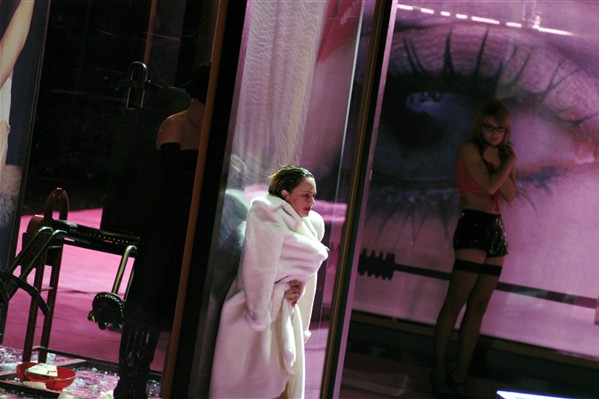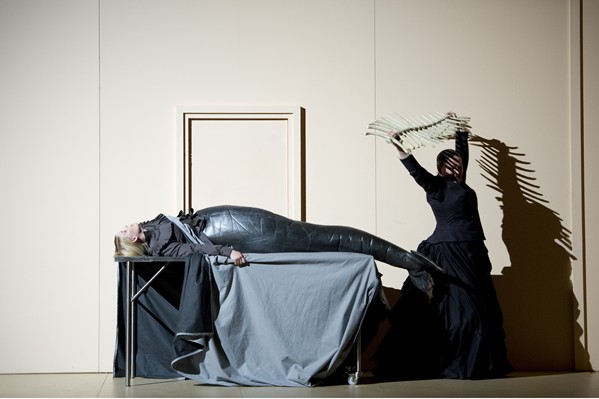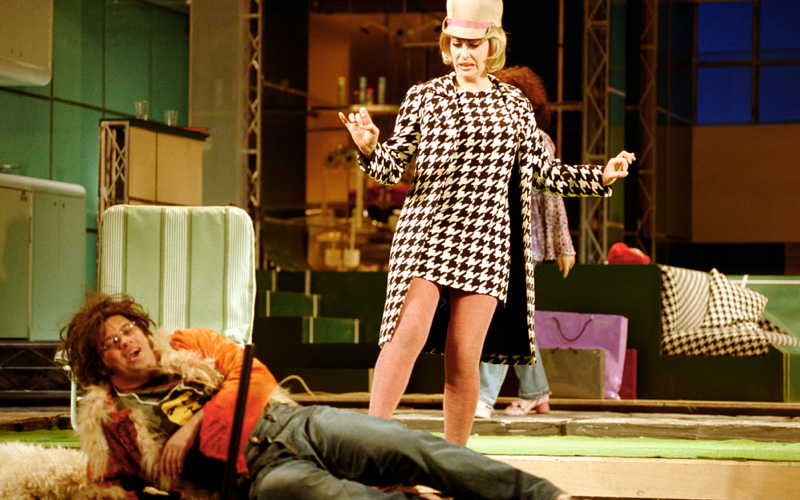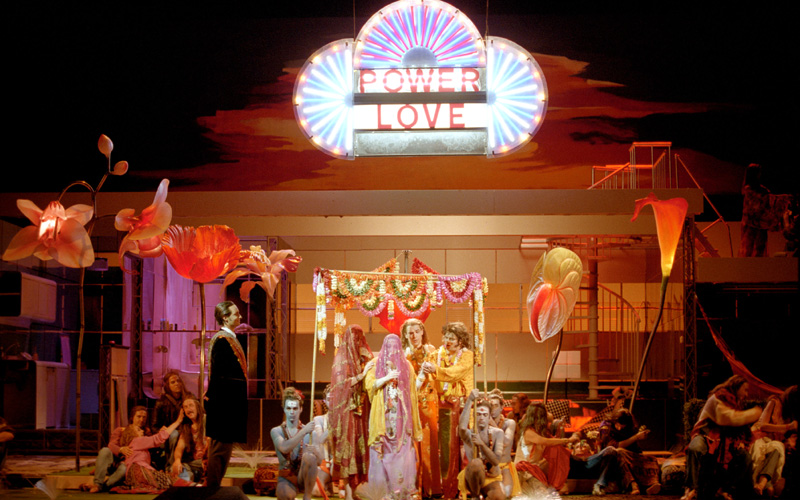By James Jorden
I apologize for long period (two months!) of radio silence: it’s been a very busy spring season in New York, broken up by a two week vacation my traveling companion and I called the “Regietournee,” a sampling of some of the opera direction going on in Germany (and other northern European theaters.) First up was a three-day, three-performance stopover in Berlin.
The first performance (March 16) was a “civilian” night, not on press credentials, a revival of Calixto Bieito‘s 2004 staging of Die Entführung aus dem Serail for the Komische Oper. Perhaps even more impressive than the director’s radical vision of the work was the energy level and precision of the performers in this extremely physical production — and all for a quick four-performance run in the midst of a busy repertory.
Bieito has a very smart if totally scruffy way of presenting a problematic work and in particular addressing some of the (until recently) unquestioned assumptions inherent in the opera, the greatest of which, surprisingly, is not the clash of values between European and Levantine cultures but rather the status of woman as either victim or rescuee in relationship to nefarious or heroic men. It seems to be Bieito’s position that being rescued places a woman in as passive a position as victimization and that, in an emotional sense, there is very little real difference between the two states.
Briefly, the action takes place in the present in a large Western or Westernized city. The “Serail” is a brothel, and Bassa Selim’s “otherness” is less based on ethnicity than on his involvement in an activity properly outside polite society: sexual trafficking. Yet Bieito neither panders to the prurient interests of his audience nor lets them off the hook by immediately establishing Selim’s establishment as a place of horrors. Rather, the action begins at the start of the overture with an image of almost content-free entertainment value: a beautiful, bikini-clad woman acrobat descends from above the stage on a trapeze, where she proceeds to do the standard death-defying balancing act.
With each new stunt, the woman flirts with the audience a bit more, arches her back to show off her lovely breasts, shuts her eyes and opens wide her lips like a showgirl. This is a deliberate tease, a demonstration to the audience of just how dangerously attractive the sex trade can appear viewed from the safety of a theater seat. Having piqued our interest, the girl slides off the trapeze and into bed with Osmin, played in this interpretation as a sort of bodyguard and henchman to the pimp Selim.
Now the lights come up on the stage proper, revealing a number of transparent glass booths with retro sexy advertising masking one wall; inside these cubicles at various times sex workers ply their trades. There’s also a transparent stall in which Osmin strips down and showers after having had sex with one of the women during Belmonte’s first solo. He later mocks Belmonte by singing “Das ist des Bassa Selim Haus” while jumping up and down nude on the bed as his partner laughs.
Pedrillo is a janitor/custodian in the club, cleaning out the cubicles and supplying clean towels, and Blonde is apparently turning tricks. In order to get Belmonte in past security, Pedrillo dresses him in drag including a sequinned minidress; it’s not immediately clear whether he’s supposed be taken for a real woman or customer of the brothel who’s into crossdressing. Anyway, the two tenors do an admirable and well-rehearsed shared task of Belmonte singing “O wie ängstlich, o wie feurig” while Pedrillo dresses him in thigh-high pleather boots.

The Janissary chorus are a rabble of pleasure seekers disco-dancing with kitschy light-up red valentine hearts. Selim enters pushing what looks like a large trunk on wheels, covered with a cloth which he eventually removes to reveal a kennel cage with Konstanze inside, wearing a pink cocktail dress and and a dog collar. During her first aria, Selim pulls down her underwear and fingers her roughly.
The violence works both ways. Blonde’s first aria is played ironically, her “sweetness” and “wheedling” a series of kicks and punches to Osmin. The gags get more and more violent (and therefore funnier and funnier) until the end of the aria, when he suddenly throws her to the floor and violently bangs her head against the stage. Then he turns upstage, urinated into a drinking glass, and hands it to Blonde to drink.
I should mention that there are “news ticker” type LED displays in various places around the set that quote lines from the libretto related to torture, specifically Selim’s famous threat of “Martern aller Arten.” And so, in the second act of this production, instead of merely alluding to these “tortures of every kind,” Selim offers an object lesson, tying Konstanze to a chair and forcing her to watch as Selim systematically rapes and then slashes to death one of the prostitutes.
The advantages of this radical approach, it seemed to me, were a) to motivate the ever more hysterical outbursts of coloratura from Konstanze (instead of leaving the high notes and roulades as vocal display) and b) to establish the brutalized quality of Konstanze’s existence as captive, so that when Selim murmurs a few comforting but authoritative words to her after all the bloodshed, she follows him unquestioningly from the stage.
Since in this version Osmin is obviously not an observant Muslim, his line about how naughty Pedrillo is to try to get him drunk is played as a gag, and the ensuing drinking song is performed while they play what is the most macho drinking game imaginable: Osmin closes his eyes and shoots at Pedrillo, and each time he misses he has to take a shot. (The game ends with Pedrillo shot in the knee, and he spends the rest of the show limping with a red-stained bandage on his leg.)
The reunion between the four lovers at the end of the second act is extremely tense and confused, with the men alternating between being revolted at the sexual abuse the women have suffered and being attracted to them to the point of trying to force sex upon them. The impression I got was that they finally settled on an uneasy alliance based on mutual self-interest: they all just wanted to escape.
The third act is done as a revenge fantasy a la Tarantino, with Belmonte and Pedrillo shooting up the whole brothel, killing sex workers and customers alike: the bloody bodies litter the stage until the end of the show. Selim manages to capture Belmonte and Konstanze, then leaves them helplessly singing their duet as he retires upstage to towel off and change into a fresh shirt and suit. He returns in time for the famous “forgiveness” scene, which is subverted when he comes right to the brink of killing the terrified Belmonte, then hands the gun to Konstanze and murmurs, “Ich liebe dich” over and over until she shoots him.
And now, with only the four lovers and the dazed Osmin left alive, they sing in chorus
Wer so viel Huld vergessen kann,
Den seh’ man mit Verachtung an!
… words that take on a sinister and disturbing meaning in this context, i.e., thanking a criminal for letting himself be murdered.
Osmin’s interruption of the jubilation is (I think) carefully played for comedy, with the bass doing stereotypical jumping up and down “rage”… until his last words, when Pedrillo calmly shoots him dead. And at this point, we get the joyous (gloating?) final verse of the vaudeville:
Nichts ist so häßlich als die Rache;
Hingegen menschlich gütig sein,
Und ohne Eigennutz verzeihn,
Ist nur der großen Seelen Sache!
And then Bieito changes the ending of the opera, though the text still makes perfect sense in context. The partying chorus return, hail Belmonte as their new leader (in other words, the beneficiary of Selim’s criminal empire) and he preens in their praise. On the very final note of the opera, Konstanze shoves a gun in her mouth and fires, unable to face another round of abuse.
Fellow blogger Opera Cake cautioned me beforehand that this Entführung would be a lot to digest, and honestly it’s still troubling me a month later. So perhaps my impressions of the next two operas in Berlin may sound a little sketchy. Anyway, here goes.
The following night at the Komische Oper was Dvorak’s Rusalka, directed by Barrie Kosky. Now, what I had seen of Kosky’s work previously generally displayed a camp element, lots of flash and sparkle, though naturally with a lot of thought behind the sequins. So I was unprepared for how stark and, well, Strindbergian this Rusalka played.
The set design continued the architectural elements of the auditorium to create a small alcove-like space for the playing area, quite shallow, framed by a false proscenium. The effect was of a lecture hall or recital space, emphasized by the complete lack of furniture or decoration. A door at center opened to a flat black void, and over stage left was a long bench built into the curve of the wall, like the seating in an early 20th century waiting room.
So sober a setting led to a performance that resolutely avoided mimesis: no hint of trees, a lake or a palace; even the celebrated moon was quite obviously a spotlight that pessimistically dimmed out before Rusalka could complete her last cry of “Mesicku, nezhasni, nezhasni!” The woodsprites are mean girls in Victorian school uniforms; the Water Gnome an older fellow casually dressed in sweater and slacks, perhaps a faculty member on his day off? Rusalka makes her first entrance as if being born from the Gnome: he sits on the bench with legs spread and she slithers out a trap door. She wears an Edwardian blouse on top, with a tail of dark gray-green silk faille trailing behind her.
Jezibaba turns out to be a Mrs. Danvers lookalike, with a brutish henchman of the Tor Johnson genre. In the first real shocker of the production, they accomplish the transformation of Rusalka to human girl in perhaps the least enchanting way possible: hauling her onto a steel operating table, then slitting open her dorsal side with a fish boning knife, roughly extracting a piece of spine with ribs attached. The soprano screams throughout the operation, quieted finally when Jezibaba chops the head off a cat and funnels its dark blood down Rusalka’s throat.

The next scenes are if anything more disquieting, because Rusalka (superbly played by soprano Asmik Grigorian) can only barely balance on her new legs, which are left completely exposed and pale below the hem of her blouse. The Prince appears in full Symbolist mode, having gone hunting in white tie and tails and arriving onstage with hands dripping with fresh blood he wipes on the white door. The love story is played without sentimentality or even romance: he is fascinated by Rusalka as a creature almost like a scientist with a specimen.
No intermission separates the first two acts, and so the action continues with the Prince trying to make over Rusalka into a human, dressing her in a young girl’s white party dress, a garment so strange to her that she shudders violently as he hooks up the back. She’s left behind to witness the scene between the Cook and the Kitchen Boy, who carry pots of boiling water onstage and then proceed to kill and gut a variety of seafood including eels and lobsters (which shriek pitifully as they’re tossed into the pot). So Rusalka has a double dose of horror, seeing creatures like herself brutally murdered, meanwhile hearing the servants’ gossip that the Prince has already lost interest in her.
The Foreign Princess is indeed exotic, done up as a sort of Shanghai Gesture dragon lady. When the Water Gnome returns to warn Rusalka, the Prince tries once more to style Rusalka, this time in a swirling black and white art nouveau ballgown. He tries to waltz with her but she is impossibly clumsy and terrified of tripping over the unfamiliar long skirt, finally losing her temper and slapping the Prince violently. At this point, the Princess returns to witness Rusalka’s humiliation: the Water Gnome produces a fishing rod, pierces Rusalka’s lip with the hook, and then swings her around and around like a caught fish.
And then, as the saying goes, it got really weird. The last act of the opera is very short on action and so is a challenge for any director. Following the original scenario, as Otto Schenk did at the Met last season, is frankly a snooze. What Kosky did was to turn the act into a series of funeral rituals, as if Rusalka’s death (or strictly, her transformation into a “bludika”) were a completely foregone conclusion. One by one a series of tall death figures in mourning clothes (some of them accessorized with gaudy diamond jewelry) arrive onstage. Rusalka is tormented by being forced to give birth to a number of half-ghost, half-fish monsters, then performs a pathetic dance to the woodsprites’ song. (During the verse about the beautiful girl’s hair, the sprite rakes her fingers through Rusalka’s scalp and pulls out hair extensions, leaving the soprano half-bald.)
The final scene is managed very simply, in a way that could have garnered awful inappropriate laughs if the artists had not played with utter concentration. The Prince dies, or anyway is paralyzed, holding tightly onto a fishing rod. Rusalka, left alone and undead, inserts the hook into her lip, leans back, and flutters her hands like fins. Her fate: an eternity of regret for ever trying to become something she was not.
And so Kosky is saying something very pessimistic about that most protean of operatic symbols, transformation. Unlike, for example, the girl in Du Maurier’s Rebecca (who morphs from a mousy waif to the stronger, nurturing partner in her relationship with De Winter) or the Kaisin in Die Frau Ohne Schatten (who successfully becomes human, winning the privilege of reproducing), Rusalka is a story of a transformation that, through no fault of the heroine, simply doesn’t work out. Kosky told this side of the story economically and “cruelly,” without the filter of the fairy tale setting or a duplication of the impressionistic sweetness of the music.
A third opera, Cosi fan tutte performed by the Staatsoper at the Schiller Theater, was the oldest production viewed on this tour, a decade after its 2001 premiere. At first glance, Doris Dörrie‘s approach appears to be a simple updating to the 1960s, with Fiordiligi and Dorabella mod chicks living in a life-size version of Barbie’s Dream House, and their deceiving boyfriend disguised in hippie garb. But as the action unfolded with plenty of entertaining farce business, the choice of era began to take on a deeper significance.

The late 1960s were a time of sexual experimentation and a questioning of women’s traditional sexual roles, so the title of the opera became something more than “All Women Do It.” Instead, it seemed to mean something more like “This Is What Everyone Is Doing,” with the implication “so why should it be considered wrong?” By the time of the mock wedding in the second act, the two women had shed both their shiny bob wigs and their bras and draped themselves in improvised Indian garb, all these lifestyle changes instigated by the “testing” lovers.
Of course, ingrained social attitudes don’t change overnight, and when the men return at the end of the opera they are not only jealous but suspicious of their fiancees’ more liberated attitudes. Thus the cheery final chorus, while still outwardly jolly, only barely papered over rage, hurt and uncertainty about the future of the relationships.

Again, it was a pleasure to see what for a German theater is a quite old production revived so crisply. A particular delight was seeing singers who elsewhere might do stereotyped “adorable” Mozartean posturing instead playing less than glamorous bourgeois types. In an early scene, Fiordiligi discovered an abandoned bra draped over a chair; when Don Alfonso unexpectedly arrived, she simply tossed it under a throw pillow: not ladylike at all. A tiny touch, but it established the important idea that the theme of sexual jealousy in this opera applies across classes. Is even a Cosi set on the Jersey Shore unthinkable?
Photos: Monika Rittershaus.
Tags: barrie kosky, calixto bieito, doris doerrie, eurotrash, komische oper, otto schenk, regie, revivals, staatsoper unter den linden, symbols, the met